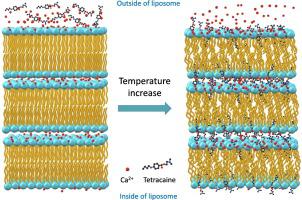Biochimica et Biophysica Acta (BBA) - Biomembranes ( IF 2.8 ) Pub Date : 2020-11-12 , DOI: 10.1016/j.bbamem.2020.183509 Carol S. Velez-Saboyá , Eric Oropeza-Guzman , Francisco J. Sierra-Valdez , Jesús C. Ruiz-Suárez

|
Although sharing common properties with other divalent cations, calcium ions induce fine-tuned electrostatic effects essential in many biological processes. Not only related with protein structure or ion channels, calcium is also determinant for other biomolecules such as lipids or even drugs. Cellular membranes are the first interaction barriers for drugs. Depending on their hydrophilic, hydrophobic or amphipathic properties, they have to overcome such barriers to permeate and diffuse through inner lipid bilayers, cells or even tissues. In this context, the role of calcium in the permeation of cationic amphiphilic drugs (CADs) through lipid membranes is not well understood. We combine differential scanning calorimetry (DSC) and Fourier-transform infrared spectroscopy (FTIR) to investigate the effect of Ca2+ on the interlamellar diffusion kinetics of the local anesthetic tetracaine (TTC) in multilamellar artificial membrane systems. Our DSC results show the interesting phenomenon that TTC diffusion can be modified in two different ways in the presence of Ca2+. Furthermore, TTC diffusion exhibits a thermal-dependent membrane interaction in the presence of Ca2+. The FTIR results suggest the presence of ion-dipole interactions between Ca2+ and the carbonyl group of TTC, leading us to hypothesize that Ca2+ destabilizes the hydration shell of TTC, which in turn diffuses deeper into the multilamellar lipid structures. Our results demonstrate the relevance of the Ca2+ ion in the drug permeation and diffusion through lipid bilayers.
中文翻译:

Ca 2+介导的麻醉剂跨磷脂多层系统扩散的增强
尽管钙离子与其他二价阳离子具有共同的特性,但钙离子会引发许多生物学过程中必不可少的微调静电效应。钙不仅与蛋白质结构或离子通道有关,还是其他生物分子(例如脂质或药物)的决定因素。细胞膜是药物的第一个相互作用障碍。根据它们的亲水,疏水或两亲性质,它们必须克服这样的障碍,以渗透和扩散通过内部脂质双层,细胞或什至组织。在这种情况下,钙在阳离子两亲性药物(CAD)通过脂质膜的渗透中的作用尚不清楚。我们结合差示扫描量热法(DSC)和傅立叶变换红外光谱(FTIR)来研究Ca 2+的影响多层人工膜系统中局麻药丁卡因(TTC)的层间扩散动力学研究 我们的DSC结果显示出有趣的现象,即在存在Ca 2+的情况下,TTC扩散可以两种不同的方式进行修饰。此外,在Ca 2+存在下,TTC扩散表现出热依赖性的膜相互作用。FTIR结果表明,Ca 2+和TTC的羰基之间存在离子-偶极相互作用,这使我们推测Ca 2+破坏了TTC的水合壳的稳定性,进而使TTC的水合壳更深地扩散到多层脂质结构中。我们的结果证明了Ca 2+的相关性 离子在药物中的渗透和扩散通过脂质双层。











































 京公网安备 11010802027423号
京公网安备 11010802027423号